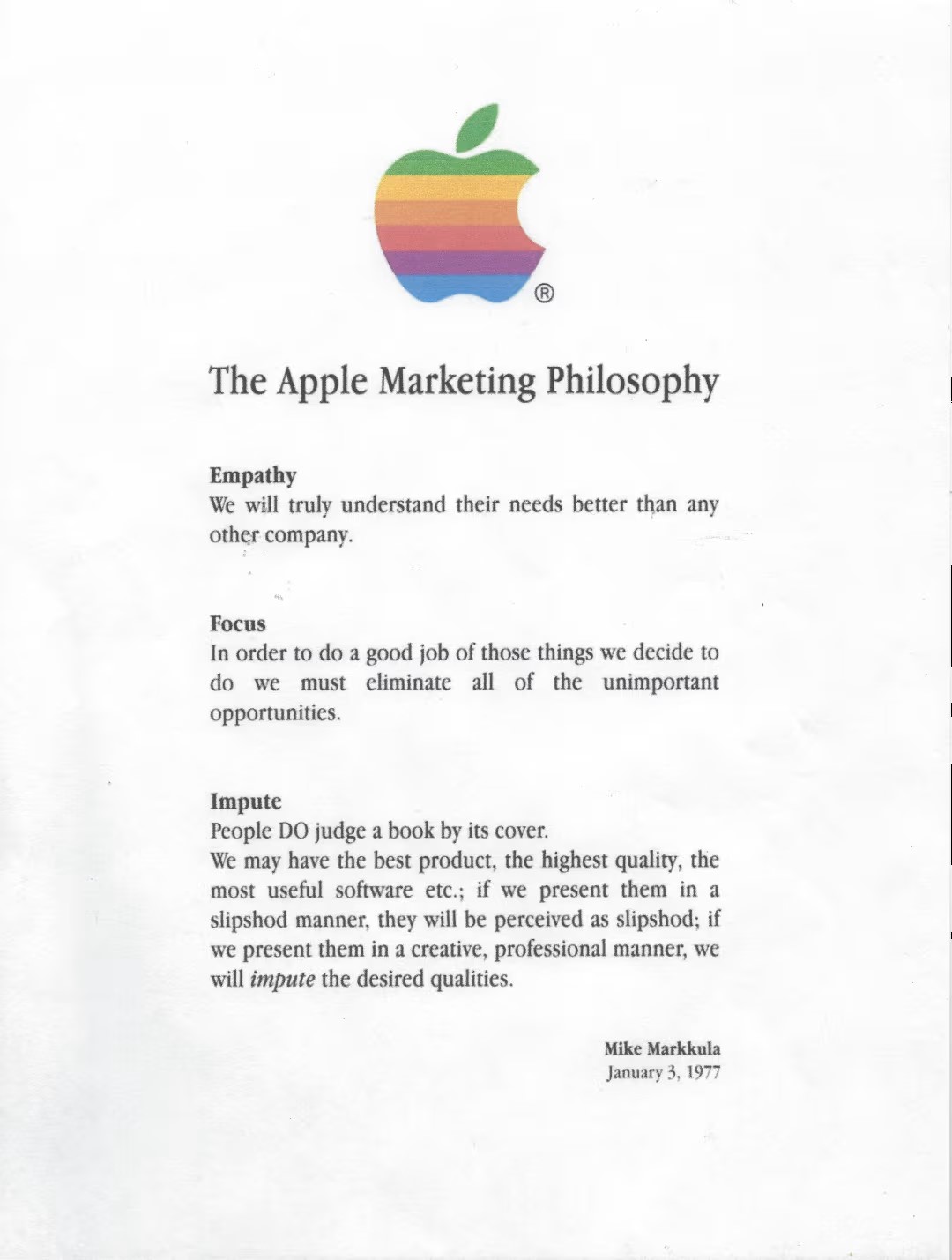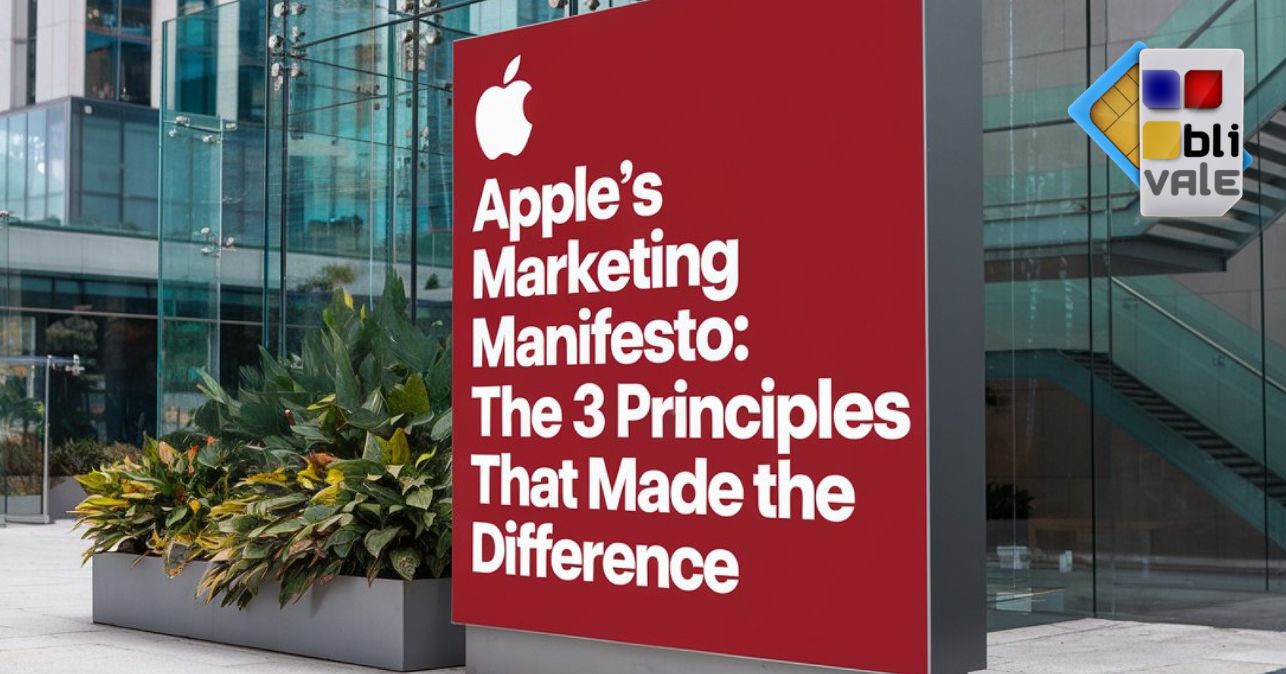1977 was a pivotal year for Apple . In that year, Mike Markkula , an early investor and mentor to Steve Jobs and Steve Wozniak , drafted a document that would become Apple's marketing and corporate strategy manifesto. This document, known as "The Apple Marketing Philosophy" , defined the core principles that guided the company to become one of the most iconic and successful brands in the world.
Even though over 40 years have passed, the principles outlined by Markkula are still extremely relevant and represent a reference model for CEOs and companies in every industry. They touch on essential aspects of how an organization should understand, focus and present itself to the market, building an authentic and lasting relationship with its customers.
In this article, we will take a detailed look at the three key principles defined in Apple’s manifesto: Empathy , Focus, and Attribution . We will discover why they are still so important and how they can be applied to create a strong and successful brand.

Empathy: Truly Understanding Customer Needs
The first principle outlined by Markkula is empathy:
1. Empathy. Original text: "We will truly understand their needs better than any other company."
The third principle outlined by Markkula is that of empathy: " We will truly understand their needs better than any other company."
This principle is the basis of everything Apple has done and continues to do. Empathy for Apple is not simply understanding what the customer wants superficially, but anticipating their unexpressed desires and needs. It is this ability to put yourself in the customer's shoes and see the world from their perspective that has allowed Apple to create such appreciated and beloved products.
Apple products are in fact designed to solve problems in an intuitive and natural way, without the user having to explicitly state all their needs. This empathetic philosophy creates an emotional bond between the brand and those who use its products, because the company demonstrates that it truly understands what matters to the customer.
Empathy is a fundamental lesson for every CEO and company: putting the customer at the center, seeing the world through their eyes and offering solutions that truly improve their life. This empathetic approach is what allows you to build an authentic and lasting relationship with your customers.
Example: The iPhone
When Apple launched the iPhone in 2007, it didn't just create a smartphone with high specifications. It understood that users wanted a device that was easy to use and could integrate multiple features into a single platform. Before the iPhone, many smartphones were complicated and unintuitive. Apple anticipated users' desire for a phone that was not only functional but also enjoyable to use.
The iPhone's user interface design was designed to be intuitive, making access to features like messaging, web browsing, and music simple and immediate. This empathetic approach revolutionized the smartphone market, creating an emotional bond between the Apple brand and its customers.
Focus: Doing less to do better
2. Focus. Original text: "In order to do a good job of those things that we decide to do, we must eliminate all of the unimportant opportunities."
The second key principle defined by Markkula is focus: "In order to do a good job at the things we set out to do, we must eliminate all unimportant opportunities."
Focus involves making clear choices about what to include and what to exclude in your product catalog and development strategy. Apple has always limited its product range to avoid wasting resources on too many projects. This principle guides the company to focus on a few essential products, such as the iPhone, iPad, and Mac, with continuous attention to detail and quality.
Focus means that the company can concentrate resources, skills and innovation on a few, selected products, making them extraordinary. This approach not only simplifies business management, but creates a perception of consistency and reliability for customers, who know they can always count on the best.
For a CEO, this is a fundamental lesson: it is better to do a few things excellently than to be scattered across many things done mediocrely. Focus allows you to excel in what you do, rather than compete on too many fronts in a mediocre way.
Example: Apple's product range
Apple has always had a very focused approach to its product lineup. Instead of offering an infinite amount of devices with minimal variations, it has chosen to focus on a few key products. For example, over the years, it has reduced the number of MacBook models available, focusing on those that offer the best performance and meet the needs of the majority of users.
This strategy has allowed Apple to devote significant resources to the development and refinement of each product. The popularity of the iPhone is a direct result of this focus. Apple has invested time and resources into perfecting the design, software, and overall user experience, making the iPhone not just a phone, but a complete ecosystem.
Attribution: The Importance of Presentation
3. Impute (Attribution). Original text: "People DO judge a book by its cover. We may have the best product, the highest quality, the most useful software, etc.; if we represent them in a slipshod manner, they will be perceived as slipshod; if we present them in a creative, professional manner, we will impute the desired qualities."
The third principle outlined by Markkula is that of attribution: "People JUDGE a book by its cover. We may have the best product, the highest quality, the most useful software, etc.; if we represent them sloppily, they will be perceived as such; if we present them creatively and professionally, we will attribute the desired qualities to them."
This principle concerns the importance of how a product is presented and perceived. People judge a product from the first glance, from the packaging, from the care with which it is packaged and from the way it is displayed. If the presentation is sloppy or poorly cared for, the product itself will also be perceived as low quality, even if excellent.
Apple has always focused on a clean, minimalist and attractive design, making the unboxing of a new product an exciting experience. This principle teaches that every detail counts: the initial impression affects the customer's trust and their perception of value.
For CEOs, it is an invitation to never neglect the presentation of the product, but to invest in the way it "communicates" quality, attention and value from the very first moment. Attention to detail and customer experience is essential to building a strong and successful brand.
Example: Apple product presentation
A classic example of the attribution principle is unboxing a new Apple product. Every time you buy an Apple product, the experience begins with the design of the box. The packaging is meticulously crafted with high-quality materials and a clean design. This creates a positive first impression that influences the perception of the product itself.
When you open an iPhone or MacBook box, the very act of taking the device out is accompanied by a sense of joy and anticipation. This approach to presentation helps create a high-quality image for Apple products. Even if the product may be excellent from a technical standpoint, without a thoughtful presentation, the customer may perceive it as less valuable.
Conclusion
The three principles outlined by Mike Markkula in 1977 - "Empathy, Focus, and Attribution" - have made Apple's philosophy timeless. Not only do they emphasize a clear strategic vision, but they also teach the importance of customer focus, simplicity, and perceived quality.
These principles offer a model that, if followed, can help any company build a strong and lasting reputation. They touch on essential aspects of how an organization should understand, focus and present itself to the market, creating an authentic and valuable relationship with its customers.
As the business world continues to evolve, Markkula’s principles remain a guiding light for CEOs and companies looking to create successful products and services. By following these timeless principles, you can build a beloved and respected brand that will stand the test of time.









